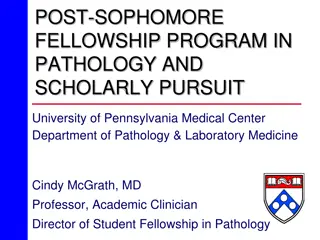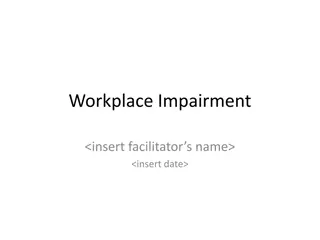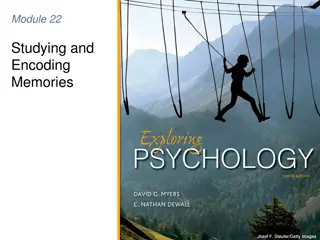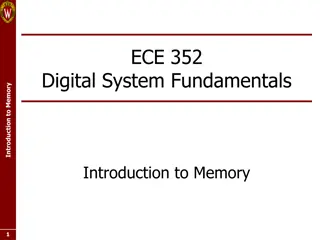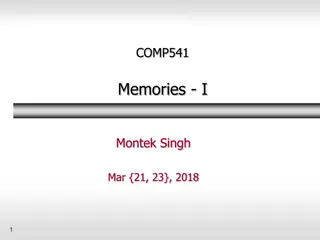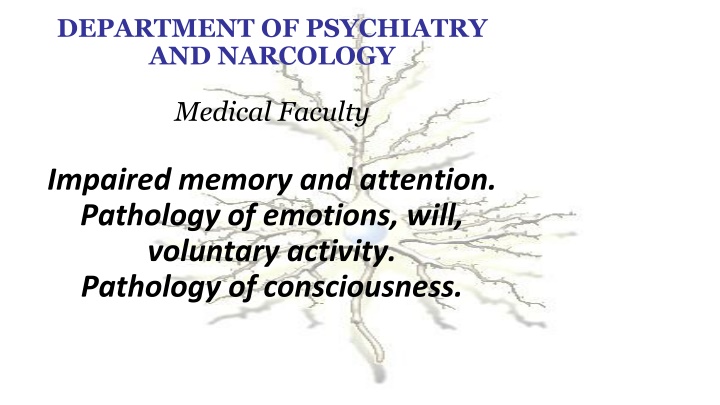
Memory Impairment and Pathology
Memory impairment, including hypomnesia, hypermnesia, amnesia, and related conditions, affects the ability to remember, store, and recall information. Pathological issues like anterograde, retrograde, and progressive amnesia can impact daily functioning and quality of life. Paramnesia adds another layer of complexity with false memories and distortions. Explore the nuances of memory dysfunction in psychiatry and narcohology.
Download Presentation

Please find below an Image/Link to download the presentation.
The content on the website is provided AS IS for your information and personal use only. It may not be sold, licensed, or shared on other websites without obtaining consent from the author. If you encounter any issues during the download, it is possible that the publisher has removed the file from their server.
You are allowed to download the files provided on this website for personal or commercial use, subject to the condition that they are used lawfully. All files are the property of their respective owners.
The content on the website is provided AS IS for your information and personal use only. It may not be sold, licensed, or shared on other websites without obtaining consent from the author.
E N D
Presentation Transcript
DEPARTMENT OF PSYCHIATRY AND NARCOLOGY Medical Faculty Impaired memory and attention. Pathology of emotions, will, voluntary activity. Pathology of consciousness.
MEMORY This is a reflection of past experience, which consists of remembering, storing, subsequently reproducing and recognizing what was previously perceived, experienced or done. The physiological basis of memory is a system of conditioned reflexes. Memory is a general cerebral function; all sections of the brain are involved in it. Fixation (memorization) Retention (preservation) Reproduction (memorization)
PATHOLOGY OF MEMORY MEMORY IMPAIRMENT Quantitative impairment Qualitative impairment hypomnesia hypermnesia amnesia confabulation pseudoreminiscence cryptomnesia
MEMORY IMPAIRMENT Hypomnesia weakening of memory due to CSA, various asthenic conditions, organic diseases of the brain Hypermnesia increased ability to remember. Occurs in manic states in schizophrenia and schizoform disorders
MEMORY IMPAIRMENT Amnesia loss of the ability to retain and reproduce previously acquired knowledge Anterograde Retrograde Anteroretrograde Progressive Fixation
MEMORY IMPAIRMENT Anterograde amnesia is the loss of memories of events immediately following the end of unconsciousness or another mental disorder. Retrograde amnesia is the loss of memories of events immediately preceding unconsciousness or another mental disorder. Anteroretrograde amnesia is a combination of two types of amnesia, when events that not only preceded the unconscious state, but also those that followed them, disappear from the patient s memory.
MEMORY IMPAIRMENT Progressive amnesia is the loss of the ability to remember and the gradual depletion of memory reserves, which occurs with a consistent pattern according to Ribot's law . Fixation amnesia loss of the ability to remember, lack of memory for current events
Paramnesia - memory impairment in the form of distortion, memory deception, false memories. Shapes: Pseudo-reminiscences Confabulation Cryptomnesia
Pseudo-reminiscences - false memories, illusions of memory. Memories of events that actually took place are related to patients in a different time period. The transfer of events is usually carried out from the past to the present, in which it replaces memory failures resulting from fixation or progressive amnesia. They are part of the structure of Korsakov's syndrome, progressive amnesia, and paramnestic dementia.
Confabulations ( fictions of memory , hallucinations of memory , delusions of imagination ) - vivid, imaginative false memories with a pathological conviction of their truth. The patient recalls events and facts that supposedly took place in his life, while in reality they were absent.
Cryptomnesia - memory distortions in which alienation or appropriation of memories occurs. Variants of cryptomnesia: Associated (painfully appropriated) memories - things heard, read, seen in a dream, in a movie, are remembered as having actually happened. False associated (alienated) memories are the opposite disorder. Real events from the patient s life fly in the memories as if they happened to someone else.
Echomnesia (Pick's reduplicating paramnesia) - memory deceptions in which some event, fact, or experience appears doubled or tripled in memories. They are part of the structure of the psychoorganic syndrome with a predominant lesion of the parietotemporal region.
PATHOLOGY OF MEMORY KORSAKOV AMNESTIC SYNDROME disorientation in place and time deterioration or lack of memory for current events pseudoreminiscences confabulation
ATTENTION A certain focus of mental activity and human consciousness on the selective perception of objects and phenomena.
PATHOLOGY OF ATTENTION PATHOLOGY OF ATTENTION SHIFTING WEAKNESS DISTRACTABILITY EXHAUSTABILITY
Excessive attention span Expressed as a decrease in the ability to concentrate for a long time on a specific phenomenon or activity due to the increased fatigue characteristic of patients
Decreased depth of attention Characterized by the predominance of passive attention over active. Increased distractibility , weakened powers of observation, superficial nature and instability of attention. Patients find themselves unable to focus attention on one thing, to concentrate on some task for a long time, and do not finish what they started, being distracted by something else. It is difficult for them to develop an idea to its logical conclusion, to limit themselves to the topic of conversation. Questions are heard inattentively, they have to be repeated, answers are given at random, are not thought through, patients are constantly distracted by extraneous things, memories, considerations.
Stiffness of attention Manifested by an inability to quickly and frequently switch attention from one phenomenon or activity to another, inertia of attitudes, clinginess, getting stuck in a conversation on any topic, difficulties in changing target directions
PATHOLOGY OF EMOTIONS PATHOLOGY OF THE EMOTIONAL SPHERE pathological decrease of mood pathological increase in mood pathological affect lack of feelings (emotions) apathy emotional dullness depression dysphoria euphoria mania weakness ambivalence inadequacy anxiety fear
PATHOLOGY OF EMOTIONS depressive syndrome manic syndrome PATHOLOGY EMOTIONS dysphoric syndrome
EMOTIONS Depression condition characterized by a depressed or sad mood and decreased activity, combined with movement disorders and various somatic disorders is a mental
EMOTIONS Depressive syndrome: Low mood to the point of melancholy Mental (ideational) inhibition Motor retardation
EMOTIONS Triad of Protopopov V.P. for depression: Pupil dilation Tachycardia Spasmodic constipation
EMOTIONS Mania is an increased joyful mood with increased desires and tireless activity, accelerated thinking speech, cheerfulness, feeling of excellent health, endurance, strength, when everything is perceived in a rosy light, dominates everything and a optimism
EMOTIONS Manic syndrome: Increased mood to euphoria Accelerating the pace of mental activity Excessive physical activity
WILL, DRIVE The individual ability for conscious, purposeful mental activity is called will . Attraction is the experience of a certain biological need that implies certain forms of behavior.
PATHOLOGY OF WILL hypobulia parabulia PATHOLOGY WILLS bulimia kleptomania dromomania pyromania suicidomania sexual perversions dipsomania abulia
PATHOLOGY OF WILL Hypobulia - decreased volitional activity, poverty of motives, lethargy, inactivity, poor, unexpressive speech, weakened attention, impoverished thinking, decreased motor activity, limited communication due to decreased responsiveness Abulia - lack of motivation, loss of desires, complete indifference and inactivity, communication due to loss of responsiveness Parabulia is a perversion of volitional activity, accompanied by corresponding activity Bulimia (polyphagia) a pathological increase in the need for food, leading to obesity, insatiable appetite cessation of
PATHOLOGY OF WILL Kleptomania is a periodically and suddenly occurring passion for theft. Dromomania is an irresistible desire for aimless wandering, changing places, and vagrancy. Pyromania is an irresistible desire to set fire, which is carried out without the desire to cause harm or damage. Dipsomania binge irresistible attraction to drunkenness Suicidomania - urge to commit suicide drinking, an
Syndromes of impaired will Abulic syndrome Apato-abulic syndrome (!)
PATHOLOGY OF VOLUNTARY ACTIVITY Excitation Stupor
VOLUNTARY ACTIVITY Stupor is a state of mental and motor retardation Apathetic stupor - a combination of absolute indifference, complete inactivity and extreme impotence, reaching the point of prostration, accompanied by insomnia Depressive stupor (gloomy numbness) is massive motor inhibition, reaching complete immobility at the height of depression. Psychogenic stupor is a reaction in the form of immobility to the experience of fear, horror, catastrophe, or the sudden death of a loved one Exogenous stupor is a state of immobility resulting from toxic or infectious damage (poisoning with antipsychotics, other substances, encephalitis, etc.) of the brain
VOLUNTARY ACTIVITY Manic excitement is an excessive desire for activity with incompleteness and unmotivated transitions from one type of activity to another, combined with increased affect
VOLUNTARY ACTIVITY Catatonic syndrome is a condition in which disturbances in the motor sphere predominate: (stupor) or agitation retardation
CATATONIC STUPOR Stages: Stupor with symptoms of waxy (catalepsy) flexibility Negativistic stupor Stupor with numbness
CATATONIC STUPOR Catalepsy A state of immobility in which any change in the patient s posture persists for a more or less long time. It appears first in the masticatory muscles, then sequentially in the muscles of the neck, upper and lower extremities, and disappears in the reverse order.
CATATONIC STUPOR Negativistic stupor Complete immobility of the patient, and any attempt to change the position causes sharp muscle tension with resistance
CATATONIC STUPOR Stupor with numbness Extreme muscle tension, in which patients are constantly in the same position, often the so-called intrauterine position, a symptom of proboscis
CATATONIC EXCITATION Motor agitation with a predominance of motor and speech stereotypies (monotonous repetition by the patient of the same words and phrases or movements
CATATONIC EXCITATION Stages: Ecstatic (confused- pathetic) excitement Impulsive excitement Hebephrenic arousal Mute excitement (silent)
CATATONIC EXCITATION Ecstatic excitement Patients take theatrical poses, sing, recite poetry, there is an expression of delight, mystical penetration, ecstasy on their faces, inconsistent their speech is
CATATONIC EXCITATION Impulsive excitement Patients perform unexpected actions, are aggressive, suddenly somewhere, try to hit, fall into a frantic rage, freeze for a while and become excited again, stereotypically (echolalia, verbigeration) jump up, run repeat words
CATATONIC EXCITATION Hebephrenic arousal Foolishness, grimacing, ridiculous, senseless patients making faces, making inappropriate, jokes laughter, jumping, flat
CATATONIC EXCITATION Mute (silent) excitation senseless, Chaotic, excitement with aggression, violent resistance, causing severe damage to oneself and others unfocused
PATHOLOGY OF CONSCIOUSNESS syndromes shutdown consciousness syndromes gloominess consciousness delirium oneiroid twilight disorder amentia PATHOLOGY CONSCIOUSNESS stun sopor coma
PATHOLOGY OF CONSCIOUSNESS Stun: The threshold of perception and sensation increases Mental processes slow down, thinking is inert, incoherent Orientation is incomplete Patients look lethargic, confused, drowsy Undulating consciousness
PATHOLOGY OF CONSCIOUSNESS Stupor stupor, deep sleep Contact with the patient is impaired, patients give the impression of being asleep Repeating meaningless movements and words Unconditioned reflexes are preserved At the moment of widespread inhibition of the entire cortex, psychomotor excitation is a revolt of the subcortex
PATHOLOGY OF CONSCIOUSNESS Coma - unconsciousness: Intense sleep Complete shutdown of consciousness All reflexes are absent Somato-vegetative disorders Goes into agony or reverse development
PATHOLOGY OF CONSCIOUSNESS Amentia : Confusion and incoherence (associative incoherence) Inability to comprehend the environment and unclear consciousness of one s self Excitement in bed, continuous stereotypical movements of the head and limbs Mood is changeable Speech is incoherent, a set of words, sounds In the evening and at night, visual illusions and hallucinations are possible There are no bright spaces Complete amnesia during the period of stupefaction






